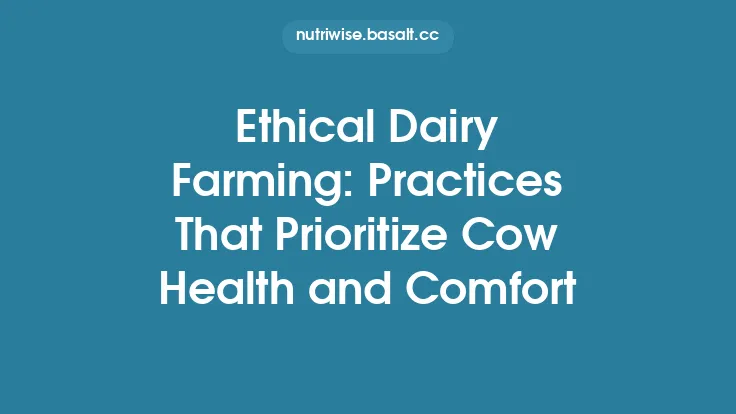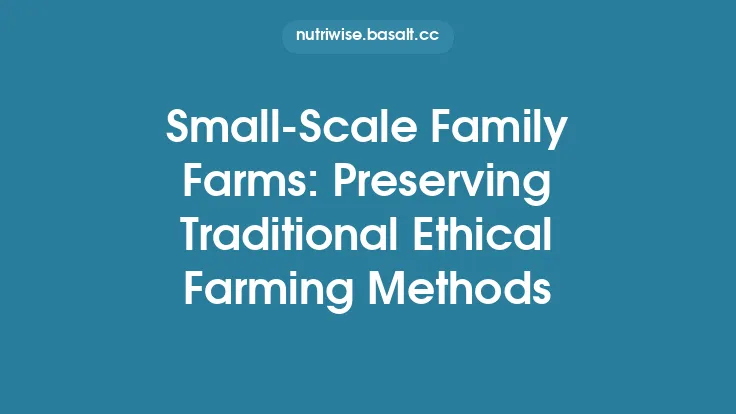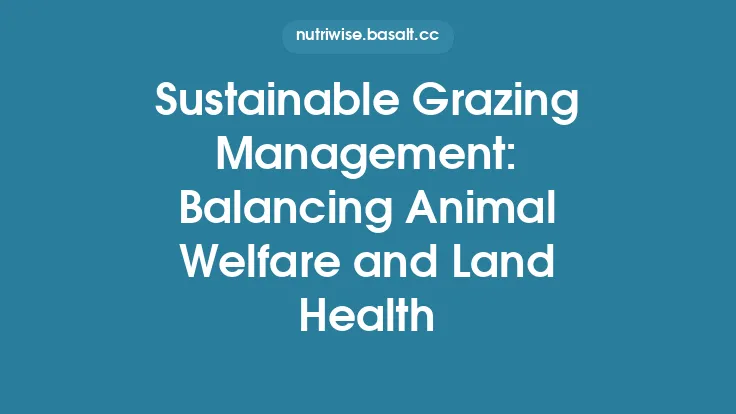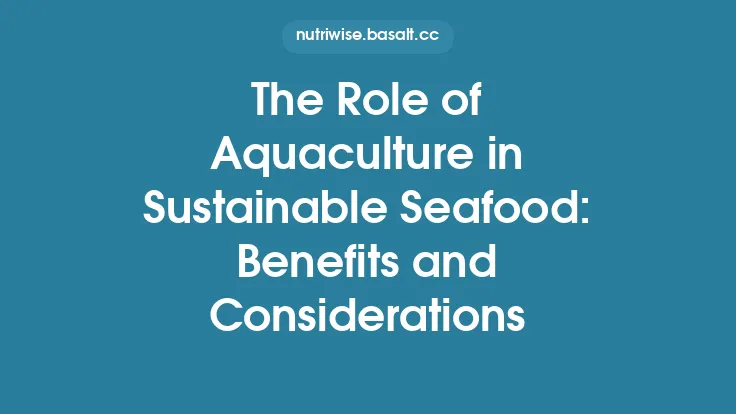Antibiotic stewardship in animal farming is a cornerstone of modern, responsible agriculture. It balances the need to protect animal health with the imperative to safeguard public health, preserve the efficacy of life‑saving medicines, and uphold ethical standards in food production. By implementing evidence‑based practices, producers can reduce unnecessary antibiotic use, mitigate the spread of antimicrobial resistance (AMR), and deliver safe, high‑quality animal products to consumers.
Understanding the Role of Antibiotics in Livestock Production
Antibiotics serve three primary functions on farms:
- Therapeutic Use – Treating clinically diagnosed infections in individual animals or groups.
- Metaphylactic Use – Treating a group of animals when a disease outbreak is imminent, even if only a subset shows clinical signs.
- Prophylactic Use – Preventing disease in healthy animals that are at high risk due to environmental or management factors.
While therapeutic use is universally accepted when justified by a veterinary diagnosis, metaphylactic and prophylactic applications have become focal points for stewardship because they often involve administering drugs to animals that may not need them. Reducing reliance on these latter categories is a key objective of stewardship programs.
Core Principles of Antibiotic Stewardship
Effective stewardship rests on a set of interrelated principles that guide decision‑making at every level of the production chain.
1. Veterinary Oversight and Prescription
Only licensed veterinarians should prescribe antibiotics for livestock. This ensures that:
- Diagnosis is accurate – Clinical signs are corroborated with laboratory testing when feasible.
- Drug selection is appropriate – The chosen antimicrobial targets the identified pathogen and aligns with susceptibility data.
- Dosage and duration are optimized – Treatment regimens follow evidence‑based guidelines, minimizing exposure while achieving cure.
2. Evidence‑Based Treatment Protocols
Standardized treatment protocols, developed in collaboration with veterinary professionals, provide clear criteria for when and how antibiotics should be used. Protocols typically include:
- Clinical thresholds (e.g., fever, respiratory rate) that trigger treatment.
- Diagnostic algorithms that prioritize rapid on‑farm testing (e.g., PCR, culture) before initiating therapy.
- Decision trees that differentiate between therapeutic, metaphylactic, and prophylactic scenarios.
3. Prioritization of Critically Important Antimicrobials (CIAs)
International bodies such as the World Health Organization (WHO) and the World Organisation for Animal Health (WOAH) classify certain antibiotics as critically important for human medicine. Stewardship programs prioritize:
- Avoiding CIAs for routine animal health issues unless no viable alternatives exist.
- Reserving CIAs for cases where susceptibility testing confirms their necessity.
4. Implementation of Antimicrobial Susceptibility Testing (AST)
AST provides data on the sensitivity of bacterial isolates to a panel of antibiotics. Routine use of AST enables:
- Targeted therapy – Selecting the narrowest effective drug.
- Monitoring resistance trends – Detecting emerging resistance patterns within a herd or region.
5. Record‑Keeping and Data Transparency
Comprehensive documentation is essential for accountability and continuous improvement. Records should capture:
- Animal identification (e.g., ear tag, RFID) linked to treatment events.
- Drug details – Name, class, dosage, route, duration, and withdrawal period.
- Clinical observations – Symptoms, diagnostic test results, and outcomes.
- Post‑treatment monitoring – Follow‑up health status and any adverse reactions.
Digital herd‑management platforms facilitate real‑time data entry, analytics, and reporting to regulatory agencies.
Biosecurity and Management Practices that Reduce Antibiotic Need
Antibiotic stewardship is most successful when integrated with robust biosecurity and husbandry practices that lower disease incidence.
Enhanced Biosecurity Measures
- Controlled farm access – Limiting entry to essential personnel and implementing footbaths, hand sanitizers, and protective clothing.
- Quarantine protocols – Isolating new or returning animals for a minimum of 30 days, with health monitoring and testing before integration.
- Sanitation regimes – Regular cleaning and disinfection of housing, equipment, and transport vehicles.
Optimized Nutrition and Housing
- Balanced rations – Providing nutrients that support immune function, reducing susceptibility to infection.
- Adequate ventilation – Preventing the buildup of ammonia and humidity that can predispose respiratory disease.
- Space allocation – Avoiding overcrowding to limit pathogen transmission.
Vaccination Programs
Strategic vaccination reduces the incidence of bacterial and viral diseases that often trigger antibiotic use. Programs should be:
- Species‑specific – Targeting the most prevalent pathogens for the given production system.
- Scheduled – Aligning with critical life stages (e.g., weaning, breeding) to maximize protection.
Monitoring Antimicrobial Resistance on the Farm
Continuous surveillance of AMR is a feedback loop that informs stewardship adjustments.
Sample Collection and Testing
- Fecal or environmental swabs – Periodic sampling of manure, water, and bedding to detect resistant bacteria.
- Targeted isolates – Collecting samples from sick animals before treatment to assess baseline resistance.
Data Integration
- Benchmarking – Comparing farm‑level resistance data against regional or national databases.
- Trend analysis – Identifying upward or downward shifts in resistance to specific drug classes.
Response Strategies
When resistance trends emerge, farms can:
- Reassess drug use policies – Phasing out drugs with rising resistance.
- Introduce alternative therapeutics – Such as bacteriophages, immunomodulators, or plant‑derived compounds where scientifically validated.
- Enhance biosecurity – To curb the spread of resistant strains.
Economic Considerations and Incentives
Antibiotic stewardship can be financially viable and even advantageous when viewed through a long‑term lens.
Cost Savings from Reduced Drug Use
- Direct savings – Lower purchase costs for antibiotics and associated administration supplies.
- Indirect savings – Decreased labor for drug administration and reduced withdrawal period losses.
Market Premiums
Consumers increasingly value responsibly produced animal products. Farms that can certify responsible antibiotic use may command higher prices or gain access to niche markets.
Risk Mitigation
Limiting antibiotic use reduces the risk of regulatory penalties, product recalls, and reputational damage associated with AMR outbreaks.
Policy Landscape and Regulatory Frameworks
Governments worldwide are tightening regulations around antibiotic use in livestock.
- Ban on growth‑promotion antibiotics – Many jurisdictions have prohibited the use of antibiotics for non‑therapeutic growth enhancement.
- Mandatory veterinary prescription – Laws require a veterinary prescription for all antibiotic sales intended for animal use.
- Reporting requirements – Producers must submit annual antimicrobial usage reports to national authorities.
Staying abreast of evolving legislation ensures compliance and positions farms as leaders in responsible production.
Education and Cultural Change
Sustained stewardship hinges on the knowledge and attitudes of all stakeholders.
- Training for farm workers – Practical workshops on disease recognition, proper drug administration, and record‑keeping.
- Continuing education for veterinarians – Updates on emerging resistance patterns, novel diagnostics, and alternative therapies.
- Consumer outreach – Transparent communication about stewardship practices builds trust and supports market demand for responsibly raised products.
Emerging Technologies Supporting Stewardship
Advances in science and technology are expanding the toolbox for responsible antibiotic management.
Rapid Diagnostic Platforms
Point‑of‑care PCR and isothermal amplification devices can deliver pathogen identification within hours, enabling targeted therapy and reducing empirical antibiotic use.
Precision Livestock Farming (PLF)
Sensors that monitor temperature, activity, feed intake, and respiratory patterns can flag early disease signals, prompting timely veterinary intervention before widespread infection occurs.
Genomic Surveillance
Whole‑genome sequencing of bacterial isolates provides high‑resolution data on resistance genes, transmission pathways, and potential reservoirs, informing both farm‑level and public‑health strategies.
Global Collaboration and Knowledge Sharing
Antimicrobial resistance knows no borders. International cooperation accelerates progress.
- Data sharing platforms – Global repositories (e.g., the Global Antimicrobial Resistance Surveillance System) aggregate farm‑level data for comparative analysis.
- Joint research initiatives – Partnerships between academic institutions, industry, and governmental bodies develop novel alternatives and best‑practice guidelines.
- Capacity building – Technical assistance programs help low‑resource farms adopt stewardship measures, reducing global AMR pressure.
Future Directions: Towards a Sustainable Antibiotic Landscape
The trajectory of antibiotic stewardship in animal farming points toward integrated, systems‑based approaches.
- Zero‑use of CIAs for routine disease prevention – Reserving these drugs exclusively for cases where no alternatives exist.
- Holistic health management – Combining genetics, nutrition, environment, and microbiome modulation to enhance innate disease resistance.
- Circular economy models – Utilizing manure and other by‑products for biogas or compost, reducing environmental reservoirs of resistant bacteria.
- Policy incentives – Tax credits, subsidies, or certification schemes that reward farms achieving measurable reductions in antibiotic use.
By aligning scientific rigor, ethical responsibility, and economic viability, the livestock sector can ensure that antibiotics remain effective tools for both animal and human health, while delivering safe, high‑quality food to a growing global population.





